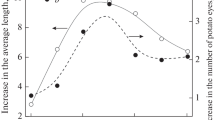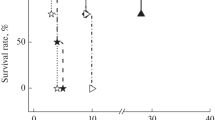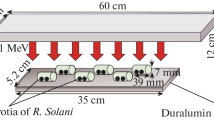Abstract
The influence of the dose of presowing γ-irradiation of tubers on the anatomical and morphological structure, yield, and tasting properties of potatoes of the Meteor variety has been studied. Morphological disorders—beak-shaped and heart-shaped tubers of a large fraction and small tubers in the form of embryos—were found in potatoes grown from tubers irradiated with doses of 500–600 Gy, although no external anatomical and morphological differences were noted in the stems and leaves of potato plants in the course of the vegetative development regardless of the presowing irradiation dose of tubers. Irradiation of seed tubers with doses of 200–300 Gy led to the highest yield and profitability and the best tasting qualities of grown potatoes. Experiments on the toxicity of potato tubers irradiated with doses of 100–1500 kGy and juice released during their radiolysis with doses of 1200–5000 kGy showed no negative effect on the animals that consumed them. At the same time, the physiological processes of digestion, excretion, and metabolism in experimental animals were not inhibited and the level of glucose in their blood remained within physiological reference values. The experimentally established highest doses of γ-irradiation of potatoes and the doses of introducing aqueous dispersions of the irradiated products into mice (gram of substance per 1 kg of live weight of the animal) that did not cause clinical manifestations were 10 g/kg for powdered potato tubers irradiated with a dose of 1500 kGy and 20 g/kg for dried juice powder released in the course of irradiation of potato tubers with a dose of 2000 kGy.







Similar content being viewed by others
REFERENCES
DeFauw, S.L., He, Z., Larkin, R.P., and Mansour, S.A., Sustainable Potato Production: Global Case Studies, He, Z., Larkin, R.P., and Honeycutt, C.W., Eds., Dordrecht: Springer, 2012, p. 3.
Nouri, J. and Toofanian, F., Pak. J. Biol. Sci., 2001, vol. 4, p. 1275.
Rezaee, M., Amasi, M., Farhani, A.M., Minae, S., and Khodadadi, M., J. Agr. Sci. Technol., 2011, vol. 13, p. 829.
Afifi, A.M.R., El-Beltagi, Y.S., Aly, A.A., and Elk-Ansary, A.E., Not Bot Horti Agrobo, 2012, vol. 40, p. 129.
Singh, S., Singh, N., Ezekiel, R., and Kaur, A., Carbohydr. Polym., 2010, vol. 10, p. 1016.
WHO Technical Report Series, no. 890: Joint FAO/IAEA/WHO Study Group on High-Dose Irradiation: Wholesomeness of food irradiated with doses above 10 kGy, Geneva: World Health Organization, 1999.
Lazarevich, S.V., Sergeeva, I.I., Lazarevich, S.S., and Azarenko, Yu.V., Radiobiologiya: kurs lektsii, Ch. 4: Prikladnaya radiobiologiya (Radiobiology, part 4: Applied Radiobiology), Gorki: BGSKhA, 2012.
Bhat, R. and Karim, A.A., Compr. Rev. Food Sci. Food Saf., 2009, vol. 8, no. 2, p. 44.
Gomes, M.E., Ribeiro, A.S., Malafaya, P.B., Reis, R.L., and Cunha, A.M., Biomaterials, 2001, vol. 22, p. 883.
Bhatnagar, S. and Hanna, M.A., Cereal Chem., 1996, vol. 73, p. 601.
Kiryukhin, D.P., Kichigina, G.A., Allayarov, S.R., and Badamshina, E.R., High Energy Chem., 2019, vol. 53, no. 3, p. 228.
Allayarova, A.S., Shitikova, A.V., Allayarov, S.R., Demidov, S.V., and Allayarova, U.Yu., High Energy Chem., 2023, vol. 57, no. 2, p. 180.
Das, A., Gosal, S.S., Sidhu, J.S., and Dhaliwal, H.S., Euphytica, 2000, vol. 114, p. 205.
Al-Safadi, B. and Arabi, M.I.E., J. Genet. Breed., 2003, vol. 57, p. 359.
Wang, Y., Wang, F., Zhai, H., and Liu, Q., Sci. Hortic., 2007, vol. 111, p. 173.
Gosal, S.S., Das, A., Gopal, J., Minocha, J.L., Chopra, H.R., and Dhaliwal, H.S., IAEA Tecdoc-1227: In Vitro Techniques for Selection of Radiation Induced Mutations Adapted to Adverse Environmental Conditions, Vienna: IAEA, 2001, p. 7.
Haverkort, A.J. and Bicamumpaka, M., Neth. J. Plant Pathol., 1986, vol. 92, p. 239.
Saif-Ur-Rasheed, M., Asad, S., Zafar, Y., and Waheed, R.A., IAEA Tecdoc-1227: In Vitro Techniques for Selection of Radiation Induced Mutations Adapted to Adverse Environmental Conditions, Vienna: IAEA, 2001, p. 61.
Sharabash, M.T., IAEA Tecdoc-1227: In Vitro Techniques for Selection of Radiation Induced Mutations Adapted to Adverse Environmental Conditions, Vienna: IAEA, 2001, p. 83.
Mironov, A.N., Bunyatyan, N.D., and Vasil’ev, A.N., Rukovodstvo po provedeniyu doklinicheskikh issledovanii lekarstvennykh sredstv (Guidelines for Conducting Preclinical Studies of Medical Drugs), Moscow: Grif i K., 2012.
Funding
This work was supported by a state contract no. АААА-А19-119041090087-4.
Author information
Authors and Affiliations
Corresponding authors
Ethics declarations
COMPLIANCE WITH ETHICAL STANDARDS
All applicable international, national, and/or institutional guidelines for the care and use of animals were followed.
CONFLICT OF INTEREST
The authors declare that they have no conflicts of interest.
CHARACTERISTICS
Water content was visually determined by cutting the tubers and scoring (9, not watery; 7, slightly watery; and 5, moderately watery). The smell was determined after the potato tubers were boiled, and it was evaluated in points (9, very pleasant; 7, pleasant; and 5, satisfactory). The taste of tubers was determined as a result of tasting boiled potatoes, and it was also evaluated in points (9, excellent; 7, good; and 5, satisfactory). The cooking property of tubers was determined visually in points (9, very strongly overcooked; 7, strongly overcooked; and 5, moderately overcooked). The darkening of raw and boiled potatoes was determined by how fast it darkened and to what extent the color changed after 20 min and 2 h for boiled potatoes or after 24 h for raw potatoes and scored (9, did not darken; 7, slightly darkened; and 5, moderately darkened).
Additional information
Translated by V. Makhlyarchuk
Rights and permissions
About this article
Cite this article
Allayarova, A.S., Shitikova, A.V., Faingol’d, I.I. et al. Effect of Gamma-Irradiation Dose on the Yield and Acute Toxicity of Seed Potato Tubers of the Meteor Variety. High Energy Chem 57, 341–350 (2023). https://doi.org/10.1134/S0018143923040021
Received:
Revised:
Accepted:
Published:
Issue Date:
DOI: https://doi.org/10.1134/S0018143923040021




